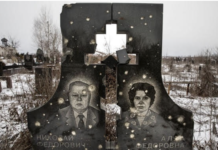Imagine a parallel world where there is no such thing as war. Instead there is a disease called Raw, which induces terrible hallucinations and also much physical suffering. It mostly affects young men, and survivors tell of the immense horror of the hallucinations, and the brave struggle of the unfortunate victims. In 1915 there was a massive outbreak of Raw in New Zealand which took nearly three thousand lives. To honour the dead these alternate New Zealanders set up Ranzac day, which also serves to honour the victims of the various outbreaks of Raw over the course of the twentieth century.
In the 21st century Raw mostly affects poorer parts of the world. New Zealand and other wealthy countries lose a handful of victims each year, but most of the victims come from countries in Africa and the Middle East.
There are some very worrying signs though that Raw could come back one day and inflict massive levels of suffering again. No cure has been found, and scientists and doctors disagree on the nature of the illness and its causes.
For the 2015 commemoration of Ranzac day, the newspapers and television shows are full to the brim with moving and heartfelt tributes to the victims of the 1915 outbreak. Families proudly tell of their personal connections to the brave young men who died, and vivid details of their shocking hallucinations form the basis of many TV shows and movies.
Strangely, the various doctors and scientists who study Raw are almost wholly excluded from the Ranzac commemoration rituals. Although it would seem that the commemoration would be a good time for doctors and scientists to air their views about the various theories and debates which the study of Raw has produced over many years, such discussion is viewed as being tasteless and disrespectful to the memory of the brave victims. Remembrance is all about a solemn sense of duty which relates very strictly to the past. Many people have become cynical and doubt that a cure for Raw will ever be found, and have little interest in listening to critical debates. The poignant emotional rituals are much more attractive and fulfilling.
* * *
In the very real New Zealand of 1938, the novelist Robin Hyde wrote a book called Nor the Years Condemn, which includes a particularly vivid description of an Anzac ceremony in the Auckland Domain. The main character of the novel is tense and conflicted: she empathises with the mourning and the suffering of the people laying wreaths, but she also wonders if these solemn acts of remembrance make future wars more or less likely.
She distinguishes between the ‘business’ of war – the interests of the combatants, the motives, the causes and the fighting itself – from the good human responses which accompany it. The carvings on a dagger, the songs which soldiers sing – these sorts of responses indicate a positive and healthy human response to something which is in itself ugly and repulsive. If we can distinguish the good parts from the ugly business of war, then it makes sense to think that we can do the same for memorials. The wreaths, the red poppies and the monuments are a positive human response to an ugly business. The fact that people come together and recite the Last Post is a healthy sign that the human spirit is at work, healing the wounds of the past. The beauty of remembrance rituals can be separated from the brutal ugliness of the war which instigated them.
Then Hyde points out that the ‘separation’ between the brute facts of war and the human responses which accompany it is far from being straightforward. The symbols and rituals of remembrance are bound up with patriotism and a set of beliefs and attitudes about other peoples and countries which predispose people to making war. The deaths which we are commemorating in ceremonies such as Anzac are framed in terms of values such as bravery, sacrifice, duty and honour. The aesthetic forms and social acts which constitute remembrance practices reflect and transmit these very same values.
As an example, consider the red poppy: it specifically encourages remembance of our dead, and more or less explicitly lends itself to the idea of ‘sacrifice for a greater cause’.
Hyde was not a pessimist however, and her utopian metaphors are very thought provoking:
If what people loved was the vine on the hilt, the Last Post, the comradeship – called by them ‘the fun of it’ – these things were not the proprietary medicines of war. The scientists of peace could work upon them, work like slaves and isolate the instinct for beautiful excitement from the instinct of fear and destruction. They might be doing so now, obscure and intent1.
It is hard not to wonder about the contemporary relevance of this metaphor today. Both the doctors and scientists of my fictional parallel world and Hyde’s ‘scientists of peace’ occupy a very marginal and doubtful place in their respective Anzac traditions. New Zealand continues to involve itself in wars of dubious legitimacy, and the fact that there are very striking parallels between the Allied invasion of the Ottoman Empire in 1915 and the American led invasions of the Middle East in the 21st century curiously fails to register on the Anzac radar.
The bravery of the Anzacs is often commented on. What kind of bravery do we need in order to truly honour their memory? What would the scientists of peace suggest?
Tim Leadbeater is a peace activist providing alternative reflections on ANZAC Day.






What kind of bravery?
The bravery to give up our dreams of control.
The bravery to say no, not fighting to make a rich man richer.
The bravery to realise the difference between the courageous dead
and the courageous living is that the living can review history and decide new directions.
Are we so sure the dead are content with the actions of their lost lives?
How about the bravery to say we know now that the war isn’t out there, that someone else isn’t the enemy; it’s inside ourselves, we’re at war with our own desires, and then deal with the consequences.
That will never happen, because it would require a level of bravery and sacrifice not yet seen on earth, cost all the things we call our “standard of living”, all our values, and all our hierarchical social arrangements. We’d prefer the immaturity of young courage, which is soley the ability to find a fight, and to lose our souls in payment for gaining the world. The military graveyards will be filling for a few thousand years yet.
One of the most poignant statements and reminders of the stupidity and colossal loss of human life during the First World War was to be found in the closing scenes of the final episode of the BlackAdder series.
Baldrick finds a nail sticking out of a ladder moments before they were whistled to go over the top and said ‘ Oooooh !! …that’s not good !!…someone could be hurt by that sticking out of this ladder ” !!
And then the final push up over the top of Private Baldrick , Capt BlackAdder company and all…
Into oblivion.
The dialogue stopped , the music background stopped , …..and we all saw our heroes in the process of climbing up and over and starting their headlong charge.
And the film turned from colour to black and white.
Then the scenes faded – and our heroes as well – to be replaced by a silent field full of red poppies.
No epitaph , no music , just silence.
And that ended the BlackAdder series.
My wife and I sat there stunned and gobsmacked. Speechless. What an incredibly powerful and potent anti – war statement . Made more so by the fact that it was done through the medium of outrageous comedy.
That silence. That really haunted .
Thanks for the insights Tim.
Thanks for printing this Martyn, and cheers for the thoughtful comments above. I write a blog which focuses on various topics relating to NZ history, WW1 and Anzac day. Some of my posts are quite long winded and heavy, but recently I have taken a more populist angle. If you are curious what the Pope, Kim Kardashian and the Anzacs all have in common, please check out
http://100yearsoftrenches.blogspot.co.nz/2015/04/what-do-pope-kim-kardashian-and-anzacs.html
Comments are closed.